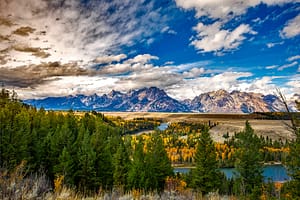The human history of Jackson Hole and the Teton Range dates back thousands of years. The stunning beauty and abundant wildlife and plants found here has drawn humans to this place for more than 11,000 years.
Nomadic paleo-Indians first entered the Jackson Hole valley shortly after Pleistocene Ice Age glaciers retreated. They left behind tipi rings, fire pits and stone tools. Summers were a time of abundance, and modern-day Indian tribes came to harvest bulbs and berries, fish the lakes and streams, and hunt wildlife. With the approach of the harsh winter, indigenous people followed their prey out of the valley in search of milder weather.
The first euro-American explorer who may have entered Jackson Hole was John Colter. He served as a member of the Lewis and Clark ‘Corps of Discovery’ expedition, but he left the expedition in the fall of 1806 and traveled through this region in the winter of 1807-1808. Unfortunately, Colter left no written record of his journeys.
People also came here for wealth. Fur trappers, known as “mountain men,” trekked west in search of beaver for fur top hats that were fashionable in the early 1800s. Many trappers including David Edward (Davey) Jackson based their operations in this area. The valley we know today as Jackson Hole was dubbed Davey Jackson’s Hole in 1829 by William Sublette, Jackson’s trapping partner. The beaver population declined rapidly with over-trapping, and when fashions turned from fur to silk hats, the era of the mountain men faded away by the 1840s.
As America expanded westward, survey expeditions mapped the landscape, documented natural resources and scouted for future railroad access. Parties lead by Captain W.F. Raynolds in 1860, Ferdinand V. Hayden in 1872, and Gustavus C. Doane in 1876 traveled to the Teton region and expanded America’s knowledge of the land and its wealth.
Even though the Homestead Act of 1862 encouraged settlement of the West, homesteaders did not arrive in Jackson Hole until 1884, becoming the valley’s first year-round residents. Over the next decade, many settlers established homesteads. Conditions were difficult, however. The soil was sandy and rocky, the winters were long and cold, and the summers were dry. Homesteaders struggled hard to raise crops and ranch cattle. They became desperate as an agricultural depression swept the country around 1920.
Wealthy Easterners enchanted with by the West visited Jackson Hole to have an authentic “cowboy” experience. Homesteaders began to shift their operations in 1908 to accommodate these priviledged visitors. Eastern ‘dudes’ (men) and ‘dudenes’ (women) paid handsomely for lodging, food, the use of a horse and other outdoor activities. Local ranchers quickly realized that ‘dude ranching’ was more profitable and easier than traditional cattle ranching, which lead to the golden age of dude ranching in the 1920s.
Development began to crowd Jackson Hole: cabins, gas stations, dancehalls, billboards and racetracks sprang up in front of the majestic Tetons. Local ranchers and businessmen wanted to preserve the valley as a “museum on the hoof” and eliminate the unwanted devlopment of the open spaces. They held a meeting in 1923 at Maud Noble’s cabin, setting in motion the conservation and preservation of this mountain valley. In 1926, John D. Rockefeller, Jr. toured the area with Yellowstone Superintendent Horace Albright. Rockefeller fell in love with the majestic mountain scenery and began purchasing private land throughout the valley. Over the next two decades, he amassed 35,000 acres through the Snake River Land Company with the intent of donating the land to the federal government to be part of Grand Teton National Park. Local residents became concerned when they discovered Rockefeller’s involvement. Transferring control of the land to the federal government meant a loss in local tax revenue, an issue finally resolved by a Congressional hearing.
This majestic place inspired and sustained people for thousands of years. Learn how humans shaped the Teton landscape through their settlement and occupations. Follow the links below to learn more about some of the historic buildings and stories of this rugged western landscape. See the historic map for locations of buildings and take time to visit an historic structure during your next visit to Grand Teton National Park.

